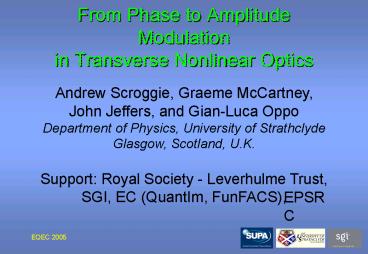From Phase to Amplitude Modulation in Transverse Nonlinear Optics - PowerPoint PPT Presentation
1 / 11
Title:
From Phase to Amplitude Modulation in Transverse Nonlinear Optics
Description:
John Jeffers, and Gian-Luca Oppo. Department of Physics, University of Strathclyde ... In order to understand the conversion formula F=0, we move to the MF Limit: ... – PowerPoint PPT presentation
Number of Views:58
Avg rating:3.0/5.0
Title: From Phase to Amplitude Modulation in Transverse Nonlinear Optics
1
From Phase to Amplitude Modulationin Transverse
Nonlinear Optics
- Andrew Scroggie, Graeme McCartney,
- John Jeffers, and Gian-Luca Oppo
- Department of Physics, University of Strathclyde
- Glasgow, Scotland, U.K.
- Support Royal Society - Leverhulme Trust,
- SGI, EC (QuantIm, FunFACS),
EPSRC
2
Transverse Phase (Amplitude) Modulations
Address Laser Beam
Nonlinear Material
Output
Phase or Amplitude Modulator
Optical Cavity
3
The Optical Parametric Oscillator Case
Address Laser Beam
Pump
Signal
?(2) Nonlinear Material
Output
Phase or Amplitude Modulator
Optical Cavity
4
The Empty Cavity Case
Phase Modulated Pump
Cavity Field after n round-trips
Reflectivity
Detuning
Diffraction
Conversion from Phase to Amplitude modulation
happens when
5
Mean Field Conditions
In order to understand the conversion formula
F0, we move to the MF Limit
Conversion from Phase to Amplitude modulation
happens at
This condition can be satisfied ONLY for negative
detunings ?
6
Why Negative Detunings
On-Axis
Only for negative detunings the on-axis and
off-axis components of the field lie in adjacent
quadrants after a large number of round trips.
For appropriate values of KK0, the two
amplitudes are exactly perpendicular to each
other. This means that an input amplitude
(phase) modulation has been fully converted into
a phase (amplitude) modulation.
Off-Axis
On-Axis
Off-Axis
7
Generic Input Modulation
K02
For an empty cavity, K0 is independent of ? and
given by
For a Kerr cavity
K0 is a function of ??
First effect of nonlinearity K0 is a function
of the kind of input modulation
8
The Optical Parametric Oscillator Case
Address Laser Beam
Pump
Signal
?(2) Nonlinear Material
Output
Phase or Amplitude Modulator
Optical Cavity
9
The OPO caseat Resonance !
Full conversion from amplitude (phase) to phase
(amplitude) modulation of the pump to the signal
is possible at resonance
Conversion from Phase to Amplitude modulation
Conversion from Amplitude to Phase modulation
10
Further results for the OPO case
Input Phase modulation
Input Amplitude modulation
The output pump reproduces the input at a K-value
different from that where pump-amplitude is
converted into signal-phase modulation
When pump-phase is converted into
signal-amplitude modulation, the output pump
reproduces the input
11
Conclusions
- Cavity Talbot-like effect can convert phase
(amplitude) transverse modulations into amplitude
(phase) modulations at precise values of the
wave-vector K of the input modulation. - In the empty cavity (under paraxial and MF
approximations) this can happen only for negative
detunings. - Nonlinearity introduces a dependence of the
critical wave-vectors from the kind of modulation - Nonlinearity shifts the detuning values of the
cavity Talbot effect making is possible to
observe it at resonance ! - A.J. Scroggie et al., to appear in Physical
Review A (2005)































